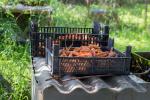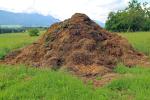
VOLTAGRO Operational Group: Study of the integration of photovoltaic production systems in irrigated crops, managed by intelligent irrivoltaic management systems
- Type Operational group
- Status In progress
- Execution 2024 -2027
- Assigned Budget 585.460,00 €
- Scope Supraautonómico
- Autonomous community Andalucía; Castilla y León; Murcia, Región de
- Main source of financing CAP 2023-2027
- Project website GO VOLTAGRO
The project will consist of a novel agrovoltaic system for use with irrigated crops (irrivoltaic), consisting of a structural module with photovoltaic (PV) panels distributed along 4 slopes with an east-west orientation, which will move over each other on the same plane, adapting their opening to the lighting and microclimatic requirements of the crop.
For each phenological stage of the crop, the following tests will be carried out:
a) opening of the waters located in the east by 15-16.5%, 30-33% and 50% and closing the waters located in the west.
b) opening to the west of 15-16.5%, 30-33% and 50% and closed to the east.
c) east and west opening of 15-16.5%, 30-33% and 50%. Based on the results obtained in the tests, climate, crop and PV production models based on artificial intelligence will be developed, which will be applied in the following year of tests for the optimal management of the irrivoltaic system, optimizing the agro-environmental behavior and maximizing the economic benefit per m2 of surface area.
Electronic, communication and algorithm systems will be developed that will form part of the irrivoltaic system, which will automatically manage the fertigation of the crop, taking into account its water and nutritional requirements in the microclimatic conditions generated by the opening and closing of the solar panels, under the objective function of maximising economic benefit and optimising agro-environmental behaviour.
Assembly of the irrivoltaic systems' metal structures. Installation and calibration of weighing lysimeters for the irrivoltaic systems installed in the experimental plots. Installation of multi- and hyperspectral sensors and cameras for crop monitoring of the irrivoltaic systems installed in the experimental plots. Development of irrivoltaic system management algorithms based on agronomic and photovoltaic responses. Development of software to determine the distribution of radiation on the crop, the microclimate, and soil moisture. Developed, installed, validated, and patented an automatic control system that manages the separation between solar panels and fertigation. Intellectual property registration of the developed software.
- 1 Determine the percentages of shading and incident radiation on the crop to optimize the production of photovoltaic and agricultural energy, in lettuce, melon and sugar beet.
- 2. Model incident radiation and shading on the crop, along with the microclimate, as a function of daylight hours and external agroclimatic conditions. Using the sensors installed in Task 1.2.
- 3 Develop an automatic control system that manages the opening and closing of solar panels and fertigation based on the algorithms obtained in previous tests.
- 4 Technical-economic evaluation of the developed system.
Currently, many agricultural producers are abandoning their crops and converting their farmland into photovoltaic (PV) production fields, seeking to increase the profitability of their operations. Meanwhile, renewable energy producers are finding it increasingly difficult to obtain land concessions for their production facilities, for ecological, agro-environmental, social, and market reasons.
For these reasons, it is believed that by rationally combining both activities—that is, by installing PV solar panels on the same land where irrigated agricultural crops are grown—and by optimizing both activities (Land Equivalent Ratio, Ground Coverage Ratio, and Price-Performance Ratio indicators), we can respond to the needs that arise. Until now, in the design of agrovoltaic installations, both in research projects and on existing farms, agricultural activity has been heavily influenced by PV production infrastructure, making it impossible for agricultural businesses to give their approval, as these infrastructures are not adapted to the necessary agricultural procedures.
It is therefore necessary to provide a greater degree of innovation, including objectives and results demanded by the market and businesses, identifying, leveraging, and optimizing the synergies between both production systems.
- Design and develop the structures and equipment of the irrivoltaic system for use in lettuce, melon, and sugar beet farms.
- Determine the percentages of shading and incident radiation on the crop to minimize water and fertilizer consumption, maximize photovoltaic and horticultural energy production, reduce environmental pollution, and achieve adaptation to climate change.
- Automatic control system that manages the separation between solar panels and fertigation, using algorithms.
- Coordinator/entity name: RESEARCH ASSOCIATION FOR THE IMPROVEMENT OF SUGAR BEETER CULTIVATION
- Postal address: CARRETERA VILLABÁÑEZ, 201- VALLADOLID- CP:47017- Spain
- Coordinator/entity email: E.ROSIQUE@AIMCRA.ES
- Telephone: 619486594
The project will involve a novel agrivoltaic system for use with irrigated crops (irrivoltaic). It consists of a structural module with photovoltaic (PV) panels arranged on four slopes with an east-west orientation. These panels will move one above the other in the same plane, adapting their aperture to the light and microclimatic requirements of the crop. Based on the results obtained from the trials, climate, crop, and PV production models based on artificial intelligence will be developed. These models will be applied during the following year of trials to ensure optimal management of the irrivoltaic system, optimizing its agro-environmental performance and maximizing the economic benefit per square meter of surface area. The electronic, communications, and algorithm systems that will form part of the irrivoltaic system will be developed. This system will automatically manage the crop's fertigation, taking into account its water and nutritional requirements under the microclimatic conditions generated by the opening and closing of the solar panels, with the objective of maximizing economic benefits and optimizing agro-environmental performance.
- ASOCIACIÓN DE INVESTIGACIÓN PARA LA MEJORA DEL CULTIVO DE LA REMOLACHA AZUCARERA
- ASOCIACIÓN DE INVESTIGACIÓN PARA LA MEJORA DEL CULTIVO DE LA REMOLACHA AZUCARERA
- CYLSOLAR
- CIDAUT
- CEOE ÁVILA
- COMUNIDAD REGANTES RIO ADAJA
- ITG
- LA UNIO
- INDEREN





